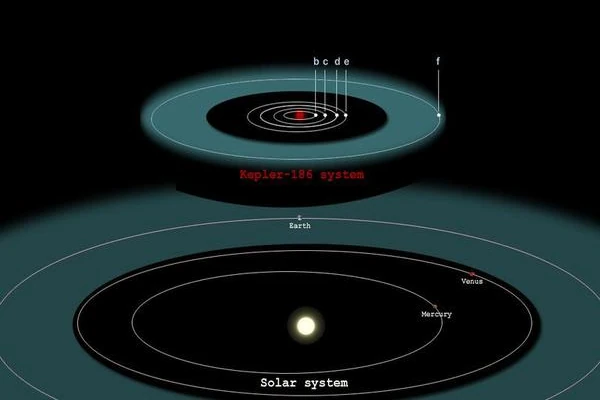
Image description: The image compares the planets of our inner solar system to Kepler-186, a five-planet stellar system located 500 light-years from Earth in the constellation Cygnus. The five planets of the Kepler-186 system orbit a red dwarf, a star half the size and mass of the Sun. The green zones are the habitable zones of the Kepler-186 system (top) and the solar system (bottom). Image credit: NASA Ames / SETI Institute / JPL-Caltech.
The Kepler-186 System is a stellar system with at least five planets, located 500 light-years from Earth in the constellation Cygnus. The five planets of the Kepler-186 system orbit a red dwarf (spectral type M), a star less massive (0.48 solar mass) and cooler (3500 K, 5778 K for the Sun) than the Sun, with a size and mass ≈0.5 compared to the Sun.
Red dwarfs are by far the most numerous stars in the Universe; 70% of the stars in the Milky Way are red dwarfs, and they can shine for hundreds of billions of years.
In April 2014, using NASA's Kepler Space Telescope, a team of astronomers discovered the first Exo-Earth (Earth-sized) in the habitable zone of the star Kepler-186.
The discovery of the exoplanet Kepler-186F confirms that Earth-sized planets exist in the habitable zone of stars other than our Sun. This is not the first planet discovered in a star's habitable zone; on December 6, 2011, NASA confirmed the discovery of Kepler-22b (2.4 R⊕), the first planet located in the "habitable zone" of its star. However, the exoplanet Kepler-186f has a size comparable to that of Earth (1.11 R⊕), although its mass is unknown, depending on its composition (water, iron, silicate).
With the JWST telescope, the chemical composition of Kepler-186f and its potential atmosphere will be revealed. “When we search for life outside our solar system, we focus on finding planets with characteristics similar to Earth,” said Elisa Quintana, researcher (SETI Institute/NASA Ames Research Center) and lead author of the article published on April 17, 2014, in the journal Science.
Kepler-186F, which orbits its star in 130 days, is located near the outer edge of the habitable zone (see image). This does not give us the average temperature of its surface, which depends on its atmosphere, which we do not yet know.
The other four planets of the Kepler-186 system, Kepler-186b, Kepler-186c, Kepler-186d, and Kepler-186e, orbit their sun every 4, 7, 13, and 22 days, respectively. So close to their star, they are certainly too hot to retain liquid water. All five inner planets of this system are less than 1.4 times the size of Earth. This major discovery is just the beginning of a long series of discoveries that will all amaze us, as the Kepler Space Telescope simultaneously and continuously measures the brightness of more than 150,000 stars.
| Class | Solar Mass | Temperature | Color | Proportion of stars |
| M | 0.08 to 0.45 M☉ | 2400 to 3700 K | Red | ≈75 % |
| K | 0.45 to 0.8 M☉ | 3700 to 5200 K | Orange | ≈12 % |
| G | 1 M☉ | Yellow | 5200 to 6000 K | ≈7 % |
| F | 1.2 to 1.6 M☉ | 6000 to 7500 K | White-yellow | ≈3 % |
| A | 1.6 to 2.4 M☉ | 7300 to 10000 K | White-blue | ≈0.6 % |
| B | M☉ | 10000 to 30000 K | Blue | ≈0.1 % |
| O | 16 M☉ | > 30000 to 50000 K | Bright blue | ≈0.00003 % |
| W | > 20 M☉ | 50 000 to 200 000 K | Bright blue to blue-white | Very rare |
| C, S, L, T... |